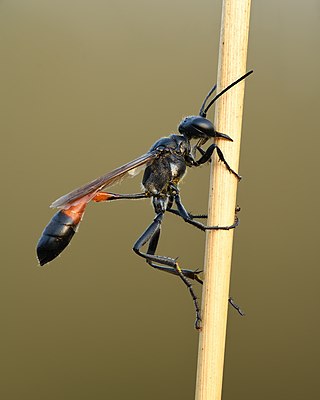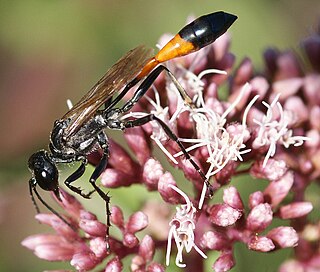
Ammophila is the type genus of the subfamily Ammophilinae of the hunting wasp family Sphecidae. Ammophila is a large and cosmopolitan genus, with over 200 species, mostly occurring in the warmer regions of all continents apart from Antarctica.

Ammophila sabulosa, the red-banded sand wasp, is a species of the subfamily Ammophilinae of the solitary hunting wasp family Sphecidae, also called digger wasps. Found across Eurasia, the parasitoid wasp is notable for the mass provisioning behaviour of the females, hunting caterpillars mainly on sunny days, paralysing them with a sting, and burying them in a burrow with a single egg. The species is also remarkable for the extent to which females parasitise their own species, either stealing prey from nests of other females to provision their own nests, or in brood parasitism, removing the other female's egg and laying one of her own instead.

Ammophilinae is a subfamily of thread-waisted wasps in the family Sphecidae. There are about 6 genera and more than 320 described species in Ammophilinae.
Ammophila ferruginosa is a species of thread-waisted wasp in the family Sphecidae.

Ammophila pictipennis is a species of thread-waisted wasp in the family Sphecidae, found in the eastern half of North America.

Ammophila placida is a species of thread-waisted wasp in the family Sphecidae. It is found in the continental United States and Central America.

Ammophila azteca is a species of thread-waisted wasp in the family Sphecidae. It is native to Canada, Mexico, and the continental United States. It is found from near-sea level to over 6,000 feet in altitude.

Podium luctuosum is a species of thread-waisted wasp in the family Sphecidae.
Glenostictia pictifrons is a species of sand wasp in the family Crabronidae. It is found in North America. It is known to be a predator of Neorhynchocephalus volaticus.
Isodontia apicalis is a species of thread-waisted wasp in the family Sphecidae from North and Central America.

Ammophila nigricans is a species of thread-waisted wasp in the family Sphecidae.

Ammophila aberti is a species of thread-waisted wasp in the family Sphecidae.

Ammophila wrightii is a species of thread-waisted wasp in the family Sphecidae.
Chalybion zimmermanni, known generally as the Zimmermann's mud wasp or blue mud dauber wasp, is a species of thread-waisted wasp in the family Sphecidae.
Ammophila juncea is a species of thread-waisted wasp in the family Sphecidae.

Prionyx foxi is a species of thread-waisted wasp in the family Sphecidae.

Isodontia auripes, the brown-legged grass-carrier, is a species of thread-waisted wasp in the family Sphecidae. The wasp will opportunistically use old nests made by Xylocopa virginica or mining bees. Larvae eat for three days and then spend two forming pupae. Oecanthus is a common prey item throughout I. auripes' range. I. auripes lives along the east coast of the United States.
Palmodes praestans is a species of thread-waisted wasp in the family Sphecidae.
Ammophila aphrodite is a species of thread-waisted wasp in the family Sphecidae. It is native to the southwest United States.

Ammophila procera, the common thread-waisted wasp, is a species of thread-waisted wasp in the family Sphecidae. It is a common species, found in southern Canada, the United States, and Mexico, and south to Central America.












